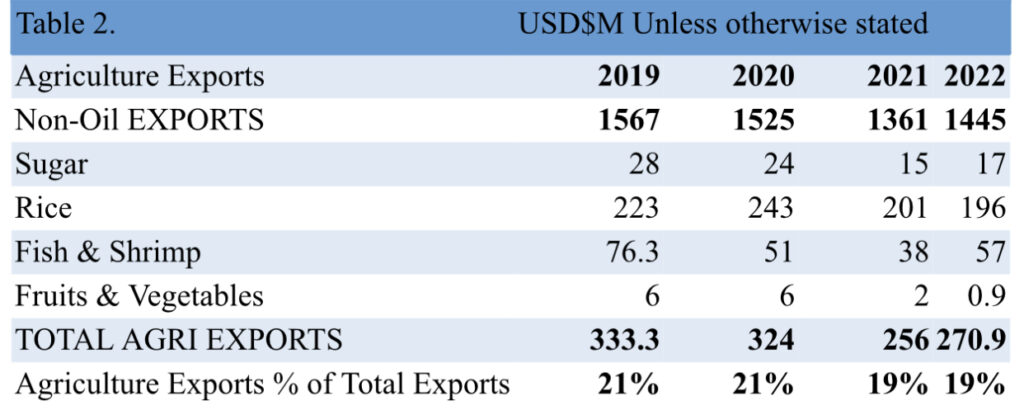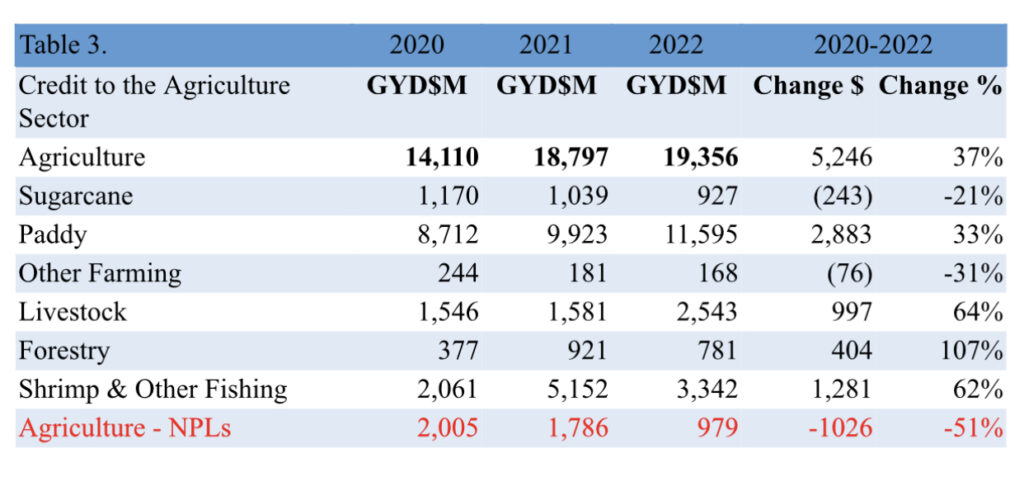Summary
Considering the agriculture sector’s performance from 2020-2022, coupled with the targets for 2023, production of aquaculture and inland fisheries are projected to increase by over 2,000% to reach over 3 million kg up from 136k kg in 2020.
Furthermore, 764 farmers are expected to be trained in aquaculture practice up from 30 in 2020; 23,223 fishing license will be issued by end of 2023; over 17,000 farmers will be trained in sustainable agricultural practices; and 251 farms will be certified to produce export commodities.
But that’s not all. Over 85,000 acres of new farmland will be made available for cultivation; and 115 km of new farm to market access road will be constructed by end of 2023.
Taken together, over 40,000 new and seasoned farmers / households (about 16.5% of the country’s total households) would have benefited from the sector and contributed to the overall productive output.
In 2022, total exports accounted for 17.33% of the sector’s nominal GDP which stood at $308 billion. This means that 82.67% or $254.6 billion of the agriculture sector’s nominal output was driven by strong demand in the domestic economy.
Against the foregoing, it can be safely concluded that the policies implemented, and investments made into the sector thus far, are yielding positive outcomes.
Introduction
This article is the second of a series of articles dedicated exclusively to examine in an in-depth manner, the development, and economic impact of the incumbent government’s policies, public investment programme in infrastructure across all sectors, programmes, and initiatives. This article focuses on the agriculture sector: the fiscal policies implemented since 2020, budgetary allocation, and the sectorial performance.
Discussion and Analysis
Fiscal Measures implemented through the National Budgets
Budget 2020
➢ Reversal of land lease fees across all sectors, water charges, land taxes and drainage and irrigation taxes back to 2014 levels, which was increased by 67% – 1900% during the 2015–2019 period.
➢ Removal of VAT on Fertilizers, Agrochemicals, Pesticides, and key inputs in the Poultry Industry and zero-rating of the Poultry Industry.
➢ Tax concessions on investment in Agro-Processing facilities, cold storage, and packaging.
➢ Special incentives for Corn and Soybean.
In budgets 2021, 2022 and 2023, there were no other specific fiscal measures for the agriculture sector. However, there were other fiscal measures implemented through those budgets that were cross-cutting, that would have impacted the agriculture sector indirectly or directly as well. For example, extending the freight cost adjustment, reduction in fuel cost by reducing the excise tax on fuel from 50% down to 0%, and the removal of VAT on air transportation cost to hinterland regions.
The budgetary allocation towards the agriculture sector increased from $9.5 billion in 2020 to $15.7 billion in 2023, representing a cumulative increase of 65% or $6.2 billion for the period.
The capital budget increased six-fold for the same period, thus the allocation relative to the size of the capital budget reduced from 13% in 2020 to 2% in 2023.
Export earnings attributed to the agriculture sector improved in 2022 over the previous year by 6% from US$256 million in 2021 to US$271 million in 2022. Agriculture exports accounts for 19% of the total non-oil exports, down by two percentage points from 2020 position of 21%.
In table 3 attached, credit to the agriculture sector increased by 37% or by $5.246 billion, cumulatively from its 2020 position of $14.110 billion to $19.356 billion by the end of 2022. Credit to the rice, livestock, forestry, shrimp & other fishing subsectors increased cumulatively by 33%, 64%, 107% and 62% respectively. Conversely, the sugar and other farming subsectors declined by 21% and 31% respectively. Notably, the level of non-performing loans (NPLs) in the sector reduced dramatically by 51% from $2 billion in 2020 down to $979 million by the end of 2022.

Agriculture GDP
In 2022, the agriculture sector recorded the highest growth rate of 12% over the last five years. The sector’s contribution to non-oil GDP in 2022 remained unchanged from its 2012 level of 25%. The agriculture real GDP increased cumulatively by 30.27% or $64 billion from $211.2 billion in 2012 to reach $275.1 billion by the end of 2022. However, the sector contracted by 11% in 2016 and 9% in 2019.
To that end, for the period 2012-2022, the agriculture sector output shrank by $27.2 billion in 2016 relative to the previous fiscal year-2015; and nearly $11 billion in 2020 relative to the previous fiscal year-2019, giving rise to a total loss of $38 billion or 14% of the sectorial contribution to GDP in 2022.
These negative outturns were attributed to several factors during the period, including bad economic policies and management by the former administration during the 2015-2019 period, compounded by flooding, inclement weather, and other exogenous factors.
Other Performance Indicators in the Agriculture Sector and Food Security
i) Production of aquaculture and inland fisheries was recorded at 135,653 kg in 2020 which increased by 643% to reach 1,003,302 kg by the end of 2022. The 2023 target is set at 3,061,000 kg, representing an increase of 2,123% over 2020.
ii) In 2021, a total of 30 farmers were trained in aquaculture practices, and in 2022, 434 farmers were trained, bringing the total to 464. The target for 2023 is another 300 farmers to be trained which will bring the total number of farmers who benefited from this programme to 764 by the end of 2023.
iii) For the period 2020-2022, a total number of 16,378 licenses were processed by the fisheries department. The target for 2023 is 6,845 which will bring the total to 23,223 new licenses issued by the end of 2023.
iv) In 2022, a total number of 6,030 farmers were trained in sustainable agricultural practices with another 11,000 targeted for 2023, thus bringing the total number to 17,030 by the end of 2023.
v) In 2022, a total of 101 farms were certified to produce wholesale food and agricultural commodities for export. In 2023, the target is another 150 farms to be certified which will bring the total to 251 certified farms by the end of 2023.
vi) In 2022, a total of 161,239 acres of cropland were under cultivation, which is projected to increase to 166,018 in 2023. In 2022, 42,032 acres of new farmlands were made available with another 43,333 to be made available in 2023, thereby bringing the total of new available farmlands for 2022-2023 to 85,365 acres.
vii) For the period 2021-2022, a total of 75 km of new farm to market access roads were constructed with another 40 km to be constructed in 2023, bringing the total new farm to market access roads to 115 km by the end of 2023. For the same period, a total of 335 km of farm to market access roads were maintained with another 50 km budgeted for 2023.
Concluding Remarks
Taken together, over 40,000 new and seasoned farmers / households (about 16.5% of the country’s total households) would have benefited from the sector and contributed to the overall productive output. In 2022, total exports accounted for 17.33% of agriculture nominal GDP which stood at $308 billion.
This means that 82.67% or $254.6 billion of the agriculture sector’s nominal output was driven by strong demand in the domestic economy. Against the foregoing, it can be safely concluded that the policies implemented, and investments made into the sector thus far, are yielding positive outcomes.
About the Author
Joel Bhagwandin, MSc., is the Director of Financial Advisory, Market Intelligence, and Analytics at SphereX Professional Services Inc. He can be reached at [email protected].











